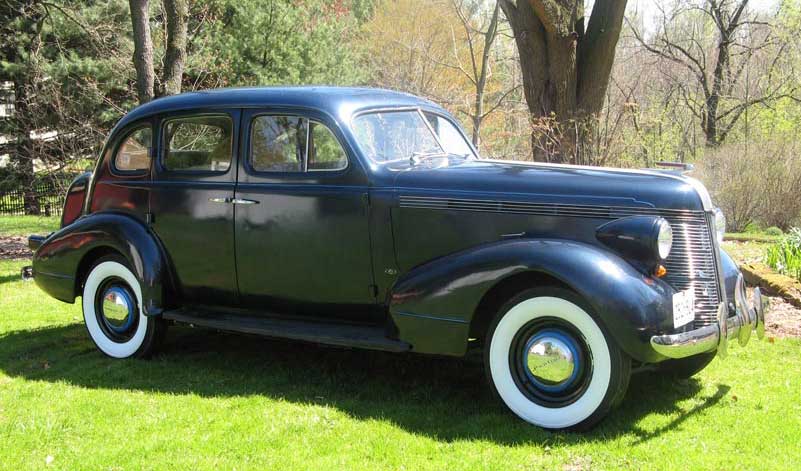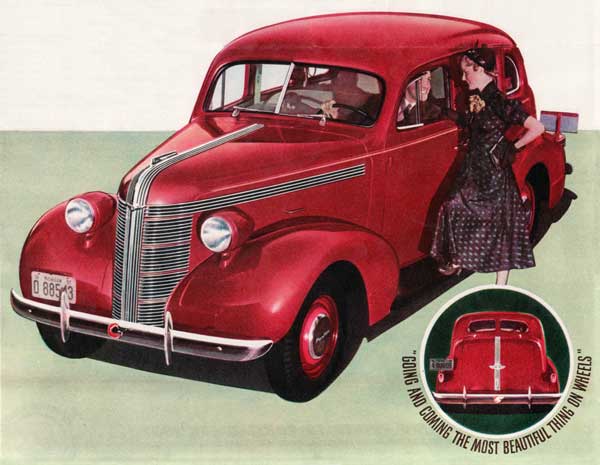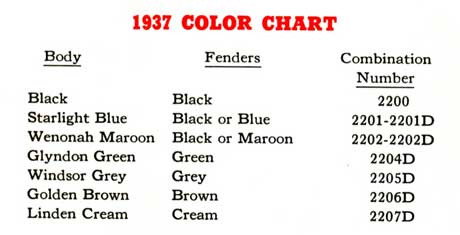
Pontiac for 1937
Pontiac had big news for 1937; there were only 2 model lines, the Deluxe Six and Deluxe Eight. They both utilized the larger Fisher B-body and rode on extended chassis’, a 117” wheelbase for the Six and 122 inches for the Eight. Early advertising listed 7 body styles with 14 models, but this was expanded to include 2 additional body styles before the end of the model year. Pontiac offered all body styles with either the Six or the Eight except the station wagon, which was only available as a Six. The Coupe seated 3 passengers, offering storage space and the spare tire behind the seat plus the trunk. The Sport Coupe seated 5 by virtue of the fact it was equipped with a pair of folding jump seats that faced each other behind the full width front seat. The Cabriolet featured a 2 passenger rumble seat and was offered with your choice of buffed, crush-grain Spanish leather or high quality worsted Bedford cloth upholstery. There were 2 and 4 door sedans available, either slant-backed with minimal trunk space or as Touring Sedans with bustle-back luggage compartments. The Deluxe Eight models offered dual, side mounted spare tires as optional equipment. The new body styles for 1937 were a 4 door Convertible Sedan built on the slant-back body and a wood station wagon.
The new bodies offered a more rakish angle to the split-vee windshields; all windows were safety-plate glass. The running boards were new and featured heavily ribbed, molded rubber surfaces. A single stop/tail lamp assembly was standard with a matching unit for the right side available at extra cost. The familiar Indian head hood ornament as used on the Six was set low on the center line while that of the Eight rose on a slender “neck” and the headdress flowed out behind and distinctly above the hood silver streak. A trunk “silver streak” was optionally available.
The dashboard was finished with the appearance of Walnut; the new instrument cluster featured a horizontal speedometer, gauges for fuel, oil pressure and temperature plus a warning lamp for the generator. Provision was made in the center of the dash for either of 2 optional radios; below was the ignition switch and knobs for headlights and throttle. Six cylinder models used a separate starter pedal while the eight cylinder starter was controlled by the accelerator. The hand brake lever was mounted under the far left side of the panel. Another new feature was the provision for hidden defroster ducts to clear the windshield. A driver’s side sun visor was standard, optional for the passenger side; dual windshield wipers were standard. The Deluxe Six offered tan-colored novelty weave wool cloth or taupe-colored good quality mohair upholstery. The Eight offered gray broadcloth with the appearance of tweed or high quality taupe-colored mohair. The front seat provided not only fore and aft adjustment, but could also be tilted for more comfortable seating and visibility. The front vent windows featured geared, hand cranked regulators that effectively maintained the desired setting; splash shields were fitted to the doors above the vent windows which allowed them to be opened regardless of the weather. The rear ventilator windows had positive latches and a wide range of opening, but didn’t offer geared regulators. All models were complete with an inside rear view mirror.
A wide variety of mechanical improvements were implemented for 1937 as well. The front suspension was revised with softer coil springs than previously used. The forged steel upper control arms perform double duty as both the top mounting for the spindle and as the arms for the hydraulic shock absorbers. The steering gear ratio was changed from 17.5 to 19:1 to reduce the effort required to turn the wheel. All of these changes resulted in a smaller turning circle than the ’36 models. The Deluxe Six rode on 6.00 x 16 wheels and tires while 6.50 x 16 was specified for the Eight.
Pontiac had big news for 1937; there were only 2 model lines, the Deluxe Six and Deluxe Eight. They both utilized the larger Fisher B-body and rode on extended chassis’, a 117” wheelbase for the Six and 122 inches for the Eight. Early advertising listed 7 body styles with 14 models, but this was expanded to include 2 additional body styles before the end of the model year. Pontiac offered all body styles with either the Six or the Eight except the station wagon, which was only available as a Six. The Coupe seated 3 passengers, offering storage space and the spare tire behind the seat plus the trunk. The Sport Coupe seated 5 by virtue of the fact it was equipped with a pair of folding jump seats that faced each other behind the full width front seat. The Cabriolet featured a 2 passenger rumble seat and was offered with your choice of buffed, crush-grain Spanish leather or high quality worsted Bedford cloth upholstery. There were 2 and 4 door sedans available, either slant-backed with minimal trunk space or as Touring Sedans with bustle-back luggage compartments. The Deluxe Eight models offered dual, side mounted spare tires as optional equipment. The new body styles for 1937 were a 4 door Convertible Sedan built on the slant-back body and a wood station wagon.
The new bodies offered a more rakish angle to the split-vee windshields; all windows were safety-plate glass. The running boards were new and featured heavily ribbed, molded rubber surfaces. A single stop/tail lamp assembly was standard with a matching unit for the right side available at extra cost. The familiar Indian head hood ornament as used on the Six was set low on the center line while that of the Eight rose on a slender “neck” and the headdress flowed out behind and distinctly above the hood silver streak. A trunk “silver streak” was optionally available.
The dashboard was finished with the appearance of Walnut; the new instrument cluster featured a horizontal speedometer, gauges for fuel, oil pressure and temperature plus a warning lamp for the generator. Provision was made in the center of the dash for either of 2 optional radios; below was the ignition switch and knobs for headlights and throttle. Six cylinder models used a separate starter pedal while the eight cylinder starter was controlled by the accelerator. The hand brake lever was mounted under the far left side of the panel. Another new feature was the provision for hidden defroster ducts to clear the windshield. A driver’s side sun visor was standard, optional for the passenger side; dual windshield wipers were standard. The Deluxe Six offered tan-colored novelty weave wool cloth or taupe-colored good quality mohair upholstery. The Eight offered gray broadcloth with the appearance of tweed or high quality taupe-colored mohair. The front seat provided not only fore and aft adjustment, but could also be tilted for more comfortable seating and visibility. The front vent windows featured geared, hand cranked regulators that effectively maintained the desired setting; splash shields were fitted to the doors above the vent windows which allowed them to be opened regardless of the weather. The rear ventilator windows had positive latches and a wide range of opening, but didn’t offer geared regulators. All models were complete with an inside rear view mirror.
A wide variety of mechanical improvements were implemented for 1937 as well. The front suspension was revised with softer coil springs than previously used. The forged steel upper control arms perform double duty as both the top mounting for the spindle and as the arms for the hydraulic shock absorbers. The steering gear ratio was changed from 17.5 to 19:1 to reduce the effort required to turn the wheel. All of these changes resulted in a smaller turning circle than the ’36 models. The Deluxe Six rode on 6.00 x 16 wheels and tires while 6.50 x 16 was specified for the Eight.
Magazine Ad Links: Deluxe 2819 A Look, A Ride, and You'll Decide Smartest, Smoothest, Open Car
Most for your Money booklet Features and Accessories Body Lube Chart Chassis Lube Chart
Most for your Money booklet Features and Accessories Body Lube Chart Chassis Lube Chart
New for 1937 was the change from a Torque-tube rear suspension to the Hotchkiss design, which allows the axle to absorb some energy during acceleration and prevents the wheels from spinning. Telescopic, double-acting shock absorbers were fitted to the rear suspension and a two-piece driveshaft was installed. This allows for flat rear floors. The standard axle ratio for both the Six and Eight was 4.37:1, the “mountain” ratio was 4.62:1 and the “plains” ratio was 4.125:1. Either of these was available at extra cost.
There was big news under the hood of either model for 1937; the Six grew from 208 to 223 cubic inches and the Eight was enlarged from 232 to 249 cubic inches. Naturally, both engines produced more horsepower as well, 85 @ 3,600 and 100 @ 3,800 respectively. The standard compression ratio was 6.2:1 for both engines, an optional 7:1 head was available for either engine The new “Scotch Mist” intake manifold featured an improved heat riser utilizing a thin-wall metal tube that dramatically increased heat transfer during cold engine operation. The system also used a long stamped steel tube to direct air from the engine cooling fan onto the heat riser thermostat. This tube has a seasonal adjustment to insure the most efficient operation of the heat riser system. The fuel pump was increased in capacity and inverted for the first time; placing it lower on the side of the engine in the slipstream of air passing beneath the car; this was done to insure against vapor lock. A vacuum pump was available in conjunction with the fuel pump for improved windshield wiper operation. Despite the larger engines with increased horsepower, fuel economy was up 10% over the 1936 models. The gains reflect the constant improvements sought by Pontiac engineers to further refine their automobiles and give the owner’s the best value for their dollars’ spent.
A wide array of factory and dealer installed accessories were available for the 1937 Pontiac. New this year was a “Tour Top” luggage carrier that mounted on the all-steel roof and was secured with suction cups and retaining straps. A commercial “pick-up” box was also available to be fitted into the trunk opening on the coupe body style; the list price was $25 and the load floor was a full 72 inches from front to back! The owner had their choice of 2 radios, both featured instrument panel controls. There were also 2 heaters available, both of which mounted under the dashboard; the new windshield defroster unit could be used with either heater and featured its own blower fan to propel the heated air onto the glass.
Pontiac noted that of the 1.3 million vehicles it had produced since 1926, over 84% were still in service when the ’37 models were introduced. Their reputation for durability and longevity was already well established. For 1937, Pontiac raised the bar yet again; offering large all-steel Fisher bodies, either 6 or 8 cylinder engines and a wide selection of optional equipment that simply couldn’t be found by any other manufacturer at any where near the price. This was Pontiac’s formula for success that carried them through until the early 1950’s. The model year production figure was 236,189, the most units produced to date.
There was big news under the hood of either model for 1937; the Six grew from 208 to 223 cubic inches and the Eight was enlarged from 232 to 249 cubic inches. Naturally, both engines produced more horsepower as well, 85 @ 3,600 and 100 @ 3,800 respectively. The standard compression ratio was 6.2:1 for both engines, an optional 7:1 head was available for either engine The new “Scotch Mist” intake manifold featured an improved heat riser utilizing a thin-wall metal tube that dramatically increased heat transfer during cold engine operation. The system also used a long stamped steel tube to direct air from the engine cooling fan onto the heat riser thermostat. This tube has a seasonal adjustment to insure the most efficient operation of the heat riser system. The fuel pump was increased in capacity and inverted for the first time; placing it lower on the side of the engine in the slipstream of air passing beneath the car; this was done to insure against vapor lock. A vacuum pump was available in conjunction with the fuel pump for improved windshield wiper operation. Despite the larger engines with increased horsepower, fuel economy was up 10% over the 1936 models. The gains reflect the constant improvements sought by Pontiac engineers to further refine their automobiles and give the owner’s the best value for their dollars’ spent.
A wide array of factory and dealer installed accessories were available for the 1937 Pontiac. New this year was a “Tour Top” luggage carrier that mounted on the all-steel roof and was secured with suction cups and retaining straps. A commercial “pick-up” box was also available to be fitted into the trunk opening on the coupe body style; the list price was $25 and the load floor was a full 72 inches from front to back! The owner had their choice of 2 radios, both featured instrument panel controls. There were also 2 heaters available, both of which mounted under the dashboard; the new windshield defroster unit could be used with either heater and featured its own blower fan to propel the heated air onto the glass.
Pontiac noted that of the 1.3 million vehicles it had produced since 1926, over 84% were still in service when the ’37 models were introduced. Their reputation for durability and longevity was already well established. For 1937, Pontiac raised the bar yet again; offering large all-steel Fisher bodies, either 6 or 8 cylinder engines and a wide selection of optional equipment that simply couldn’t be found by any other manufacturer at any where near the price. This was Pontiac’s formula for success that carried them through until the early 1950’s. The model year production figure was 236,189, the most units produced to date.


'37 owned by Arnold & Lois Landvoigt

